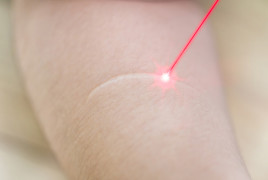Melasma: Self-care
Tips to make melasma less noticeable
If you have melasma, dermatologists recommend these tips for achieving a more even skin tone.
3 ways to make melasma less noticeable
Melasma is a common skin problem that causes brown, tan, grayish brown, or bluish gray patches on the face, depending on your skin tone. Although the exact causes of melasma are unclear, common triggers include sunlight, pregnancy, and birth control pills.
If you have melasma, dermatologists recommend the following tips for achieving a more even skin tone:
Protect your skin from the sun every day. One of the most common treatments for melasma is sun protection.
Since sunlight triggers melasma, it is important to protect your skin every day, even on cloudy days and after swimming or sweating. Whenever possible, seek shade when outdoors and wear sun-protective clothing, such as a wide-brimmed hat and sunglasses with UV protection. For more effective protection, select a hat that has an ultraviolet protection factor (UPF) number on the label.
Apply sunscreen to all skin not covered by clothing. Choose a sunscreen that offers:- Broad-spectrum protection
- Water-resistance
- SPF of 30 or more
- Zinc oxide and/or titanium dioxide to physically limit the effects of the sun’s rays on your skin and iron oxide
Apply sunscreen 15 minutes before going outside, and reapply it at least every two hours.Along with protecting your skin from the sun, you need to stay out of tanning beds and never use sunlamps
Indoor tanning devices can worsen melasma and prevent treatment from working.

Choose gentle, fragrance-free skin care products. If a skin care product burns or stings when you use it, the product is irritating your skin. This may darken dark spots.
Avoid waxing. It’s important to avoid waxing areas of the body with melasma. Waxing may cause skin inflammation, which can worsen melasma. Ask a dermatologist about other types of hair removal that may be right for you.
If your melasma does not go away, see a board-certified dermatologist to discuss available treatments for melasma, such as prescription medications or in-office procedures.
Images
Video created by the American Academy of Dermatology.
Getty Images
Reviewed by:
Arturo Dominquez, MD, FAAD
Ivy Lee, MD, FAAD
Last updated: 2/15/22
 Think sun protection during Skin Cancer Awareness Month
Think sun protection during Skin Cancer Awareness Month
 How to care for your skin if you have lupus
How to care for your skin if you have lupus
 Practice Safe Sun
Practice Safe Sun
 Sunscreen FAQs
Sunscreen FAQs
 Fade dark spots
Fade dark spots
 Hidradenitis suppurativa
Hidradenitis suppurativa
 Laser hair removal
Laser hair removal
 Scar treatment
Scar treatment
 Botox
Botox
 Kids' camp - Camp Discovery
Kids' camp - Camp Discovery
 Dermatologist-approved lesson plans, activities you can use
Dermatologist-approved lesson plans, activities you can use
 Find a Dermatologist
Find a Dermatologist
 Why choose a board-certified dermatologist?
Why choose a board-certified dermatologist?